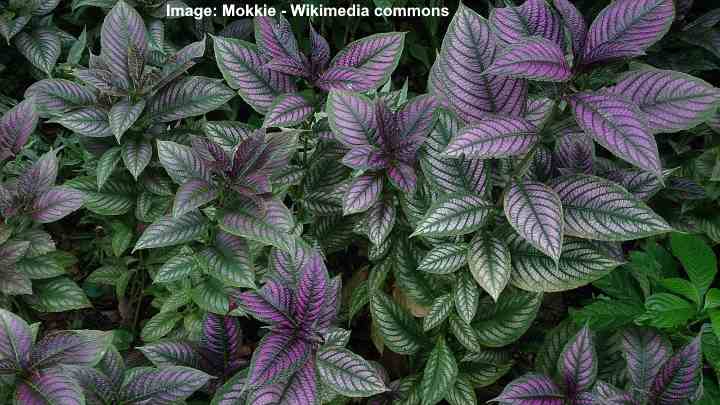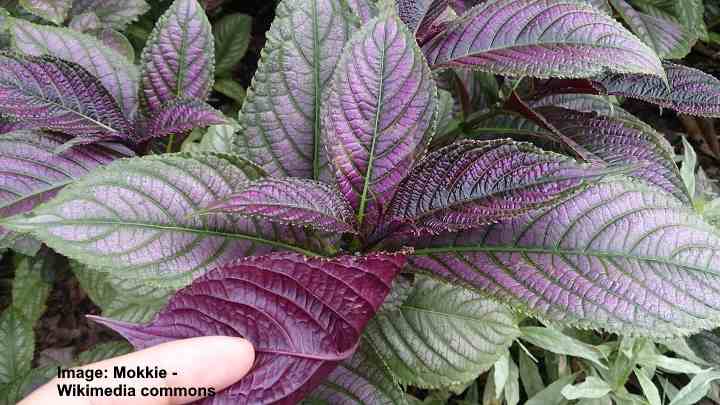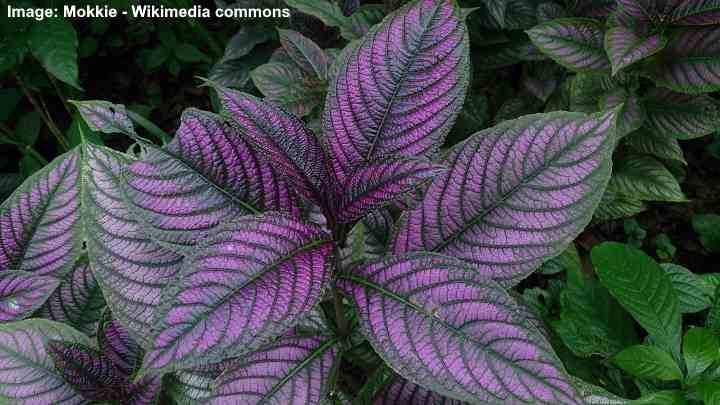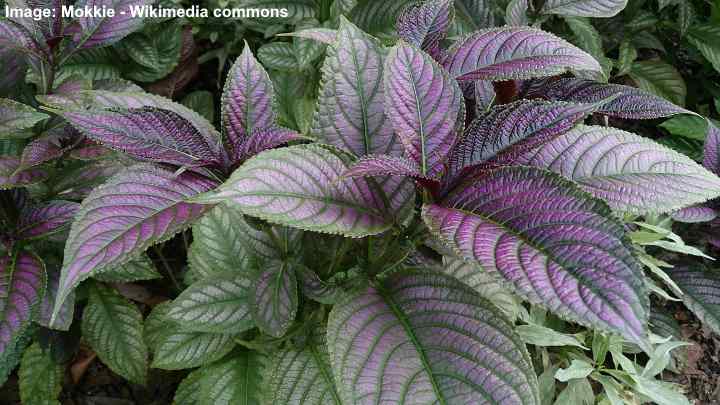Persian Shield (Strobilanthes Dyerianus): Plant Care for Indoors and Outdoors (with Pictures)

Persian shield (Strobilanthes dyerianus) is an attractive tropical evergreen plant with variegated iridescent purple and green lance-shaped leaves. As a tender perennial, the Persian shield grows outdoors in warmer, tropical climates and as an annual in temperate regions. Persian shield also thrives as a stunning easy-care houseplant. Its exotic silvery metallic foliage makes this plant an eye-catching feature.
This article is a complete guide to growing the Persian shield in your garden as a perennial or annual, or tropical houseplant. At the end of the article, you’ll find helpful solutions to growing issues with the Persian shield.
Persian Shield Facts

Persian shield has stunning foliage with purple, green and silver leaves
The Persian shield (Strobilanthes dyerianus) is an exotic flowering plant in the family Acanthaceae. Native to southeast Asia, this evergreen shrub grows as ground cover in dappled shade on rainforest floors. The warm, humid conditions keep this soft-stemmed shrub’s shiny purple, lilac, and silvery foliage lush and vibrant.
Persian shield grows outdoors in USDA zones 10 and 11. The tender perennial has shrubby growth and matures to around 3 ft. to 4 ft. (1 – 1.2 m) tall and 3 ft. (1 m) wide. For most plant lovers, the best way to enjoy this stunning iridescent foliage plant is by growing it indoors.
Although the plant’s name is Persian shield, the tropical evergreen shrub originates in Myanmar. The plant’s common name comes from the leaves that look like silvery armor shields. Other common names for Strobilanthes dyerianus are royal purple plant and Burmuda coneflower.
Persian Shield Plant Care Indoors
To care for Persian shield indoors, grow the royal purple plant in a sunny spot, protected from direct sunlight. It grows best in a rich, loose, well-draining potting mix. Water the soil regularly to keep it moist, but don’t allow it to become soggy. Keep temperatures between 60°F and 75°F (16°C – 24°C) and keep humidity high.
Persian Shield Plant Care Outdoors
To grow a Persian shield plant in the ground, choose an area of your garden with dappled sunlight. Plant in rich, fertile soil that has good drainage. Add mulch around the roots to keep the soil evenly moist. If growing as a tender perennial, bring it indoors when the temperature drops below 60°F (15.5°C).
Persian shield grows outside as an evergreen perennial in warm climates and an annual in temperate areas.
Persian Shield Flower
Persian shield produces insignificant spikes of lilac-colored, funnel-shaped flowers on the ends of short stems. The small flowers have five lobes, and many bloom on one stem. The shape of the flowering cone is the reason the Persian shield is also called Burmuda coneflower. Growing indoors, it’s uncommon for the exotic Persian shield houseplants to flower. If royal purple plant flowers, it usually blooms in wintertime.
Persian Shield Leaves

Persian shield leaves
Persian shield leaves are the most attractive feature of the plant. Persian shield has lanceolate-shaped leaves that have a stunning iridescent purple or lilac color with a silvery metallic sheen, and dark purple undersides. Prominent dark green veins and serrated margins contrast with the deep purple hues. Purple Persian shield leaves grow between 6” and 8” (15 – 20 cm) long. Hot conditions bring out the best colors in Persian shield leaves.
Persian Shield Companion Plants
The dramatic appearance of Persian shield plants means that they pair well with other colorful landscaping plants. Here are some of the best companion plants for Persian shield:
- Curcuma—The beautiful white, pink, or purple long-lasting flowers of curcuma plants contrast beautifully with Persian’s shields shimmering purple foliage.
- Gardenia—This plant has stunning showy white flowers and strong scents ideal for growing alongside a Persian shield.
- Impatiens—The showy, brightly colored impatiens flowers offer a bold contrast to the dark, purple iridescent foliage.
- Lobelia—The spectacular lobed flowers on white or red lobelia plants give the Persian shield an even more dramatic appearance.
Persian Shield (Strobilanthes dyerianus) Care Guide
Let’s look in more detail at the best way to care for a Persian shield so that its colorful purple leaves always look vibrant and healthy.
Where to Plant Persian Shield in Landscapes
Persian shield plants grow as evergreen perennials or annuals, depending on the climate. The dramatic purple foliage and relatively low growth height mean they are ideal as eye-catching border or edging plants. You can also grow Persian shield plants in mixed beds as a stunning focal point.
If growing Persian shield as an annual, it’s best to grow in containers. This way, you can take the bushy purple plant indoors when the weather cools.
Persian Shield Light Requirements

Grow Persian shield plant in indirect sunlight
The Persian shield likes plenty of light, as long as it’s protected from direct sunlight. Indoors, you can keep the plant on a sunny windowsill if it’s behind a sheer curtain. A Persian shield plant grows well where it gets morning sun and shade in the afternoon.
You can tell if light conditions are ideal for the Persian shield by its colorful foliage. If the plant grows in too much shade, the leaf growth becomes leggy as the stems stretch toward the light. Also, not enough light tends to cause the silver shine on the purple leaves to fade.
Similarly, too much sunlight will bleach the dark colors on the leaves. In time, the foliage may lose its iridescent purple hues.
The Best Soil for Growing Persian Shield Plants
The Persian shield grows best in rich, well-draining soil that has plenty of organic matter. Create a potting mix for a Persian shield houseplant by combining two parts peat moss, one part houseplant soil, and one part perlite. This type of soil mix contains organic matter along with perlite as a drainage amendment.
A rich potting soil mix for tropical houseplants should retain moisture without becoming waterlogged. So, peat moss and compost are ideal for their moisture-retaining properties. Also, compost contains plenty of nutrients for healthy growth. Peat moss also increases the soil’s acidity slightly. The ideal pH range is 5.5 to 7.5.
Growing a Persian shield plant indoors in pots requires good drainage. You can add inorganic amendments such as perlite, gravel, or horticultural sand to allow water to drain freely. These amendments also ensure that oxygen gets to the plant’s roots.
If growing a Persian shield plant in your garden, ensure that the ground is well-draining.
How to Water Persian Shield Houseplants

To care properly for Persian shield houseplant, keep the soil moist but not soggy
Water Persian shield plants as often as once or twice a week to keep the soil constantly moist. When growing the plant indoors, wait until the top layer of soil dries between watering. In warm weather, this should be at least once a week. In winter, you should water the plant less frequently.
You know it’s time to water the plant when the foliage becomes droopy. However, it would be best if you rarely let the soil dry as this stresses the plant.
The best way to water a potted Persian shield is to use room-temperature filtered water. Pour enough water until it drains from the pot’s drainage holes. After the excess water has dripped out, place the pot back on the saucer.
Here are a few factors that affect how often you must water a Persian shield houseplant:
- Potted Persian shield plants growing in the shade require less water.
- Soil moisture in unglazed terracotta pots evaporates faster than plastic pots.
- Plants in larger pots require less watering; however, moisture levels are difficult to control if the pot is too large.
Top tip for watering Persian shield plants: Avoid splashing water on the tropical leaves as this can cause leaf spotting.
Watering Persian Shield Plants Growing in the Ground
Shrubby Persian shield plants growing in the garden need to grow in even, consistently moist ground. Depending on the climate, you may need to water the purple Persian shield shrubs weekly. It’s also a good idea to mulch around the root area to lock in moisture. During warm winters in zones 10 and 11, you should water less frequently.
Purple Shield Temperature Range
Purple shield thrives in average room temperatures between 60°F and 75°F (16°C – 24°C). Warm temperatures keep the royal purple plant growing well and retain the brilliant leaf coloration. The purple houseplant can withstand cooler temperatures, but the foliage colors may start to fade.
As with growing most tropical houseplants, avoid sudden fluctuations in temperature. This can easily happen in summer if the Persian shield pot is near a drafty window or in the air-conditioning flow. In winter, keep the purple plant in a warm location but away from hot radiators or air vents.
Strobilanthes dyerianus is a tender perennial that grows outdoors throughout the year in zones 10 and 11. The royal purple plant may survive warm years in zone 9. However, in zone 8 and below, you should plan on overwintering the Persian shield indoors.
The Persian shield may survive light frosts, and it will die back to the ground. However, freezing conditions can cause the plant and its roots to die.
Humidity Requirements for Healthy Purple Shield Growth
The Persian shield is a high humidity plant and thrives when there’s moisture in the air. Indoors, humidity should be at least 40 percent. However, higher air moisture levels are better. Dry air causes the silvery purple and green leaves to droop and become crispy.
The best way to ensure adequate humidity for a Persian shield is to sit the potted bushy houseplant on a pebble tray. Put a layer of decorative pebbles in a tray and pour in water until it’s halfway up the stones. Place the plant on the pebbles. The water evaporates, creating humid conditions for the foliage.
You don’t need to mist Purple shield leaves as it doesn’t help with humidity, and you can spoil the leaves’ appearance.
Strobilanthes dyerianus Growth Rate
The Persian shield is a fast-growing shrubby bedding plant when growing in hot, humid conditions. The purple mounding plant grows up to 4 ft. (1.2 m) tall and 3 ft. (1 m) wide. Cool weather and shade impact the plant’s growth.
Growing in containers, the Persian shield’s growth is restricted by the pot’s size and indoor conditions.
The Best Fertilizer for Growing Purple Shield Plant
Potted Persian shield plants benefit from monthly fertilization during the growing season. Use a balanced NPK, water-soluble houseplant fertilizer diluted to half strength. Regular feeding every four weeks helps promote root growth and preserves vibrant leaf color. Don’t apply fertilizer during the winter months.
You can use a slow-release fertilizer for Persian shield plants growing in the ground.
How to Prune Persian Shield
Regular pruning of Persian shield foliage helps keep its growth compact and bushy. In spring or summer, cut off any leggy, unsightly stems to encourage new leaves to grow. In the garden, you can trim back the silvery purple Persian shield leaves at the end of winter so that the stems are around 1 ft. (30 cm) high.
To pinch back the Persian shield, snip the stems at an angle just above a leaf. Remember that Persian shield plants are relatively resilient, and you can prune them aggressively to keep growth full and bushy.
You can also remove any flower stalks that appear to help concentrate growth in the vibrant foliage.
Persian Shield Plant Propagation

The easiest way to Propagate Persian shield plant is through stem cuttings
The best way to propagate a Persian shield is by stem cuttings. Cut healthy stems about 2” or 3” (5 – 7.5 cm) long, just below the node. Remove the leaves nearest to the cut end. You can then root the Persian shield cutting in water. Change the water daily. When 1-inch (2.5-cm) roots appear, you can transfer the rooted cutting to an appropriate potting soil.
After repotting the rooted stem, cover the pot with a plastic bag to seal in moisture and heat. Keep the soil moist by misting it regularly. After about two to five weeks, the plant should start growing. You can repot it in a larger pot or the garden.
Repotting Persian Shield Houseplants
Established Persian shield houseplants rarely need repotting. You should repot younger plants every year until they reach the size you want. Then repot the bushy purple plants every two or three years. However, if the plant looks healthy and is growing well, you can leave it in the pot.
When choosing an appropriate pot, look for a deep container. Persian shield roots tend to stretch deeply, and the extra soil will keep the roots moist and healthy.
Signs that it’s time to repot a Strobilanthes dyerianus are if roots are poking out the drainage holes, water doesn’t drain well, or growth in summer seems to slow down.
Pests Affecting Persian Shield Growth
Strobilanthes dyerianus is relatively resistant to most pests when growing outdoors. It is also somewhat deer and rabbit resistant.
Indoors, spider mites, aphids, or mealybugs can affect its growth. You can get rid of these pests quickly by using a neem oil spray.
To rid Persian shield houseplants of bugs, mix 2 tsp. neem oil and 1 tsp. dish soap with 1 quart (1 l) of lukewarm water. Pour in a spray bottle and thoroughly douse all the foliage and stems with the neem oil solution. Repeat once a week for best results.
To help keep your plant free of pests, it’s vital to look for the early signs of common houseplant pests. Early intervention can prevent bugs, mites, and other pests from becoming a significant issue.
Diseases Affecting Persian Shield Growth
Diseases rarely affect Persian shield growth. You can avoid common issues such as powdery mildew or other fungal plant diseases if you water the plant regularly and keep the soil moist but not soggy.
Is Persian Shield Plant Poisonous?
Persian shield is generally considered non-toxic to pets and is not poisonous to dogs or cats. Some people say that the sap from the stems can cause mild skin irritation.
FAQs About Persian Shield (Strobilanthes dyeriana) Care
Persian shield is a relatively hardy plant that thrives in warm, humid conditions. However, a few issues can cause the beautiful metallic purple foliage to wilt and suffer.
Why is my Persian shield dying?
A Persian shield plant can look like it’s dying if the soil is parched. As a tropical plant, a Persian shield needs to grow in moist soil and relatively humid conditions. The good news is that soaking the soil with water usually quickly revives the plant, bringing it back to life.
Why is my Persian shield turning brown?
Persian shield leaves can lose their color and turn crispy brown if humidity is too low or the soil is too dry. The best way to resolve this issue is to water the soil thoroughly and increase room humidity.
Why are leaves fading on my Persian shield plant?
Too much light or growing in continual shade will cause the Persian shield leaves to fade. The iridescent purple Persian shield leaves will lose their silvery metallic sheen and vibrant lilac and purple colors. Move the potted Persian shield to a brighter location and protect the foliage from direct sunlight to bring back the Persian shield leaves’ vibrancy.
Related articles:
